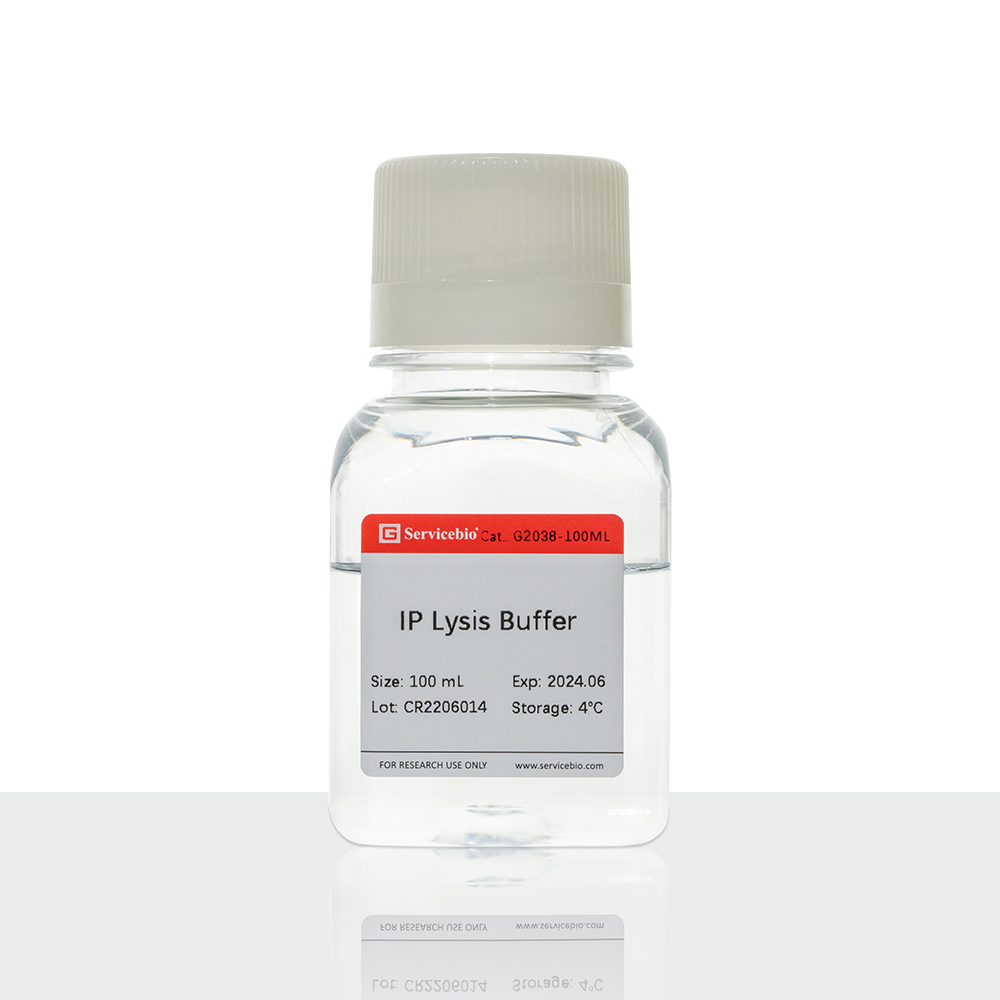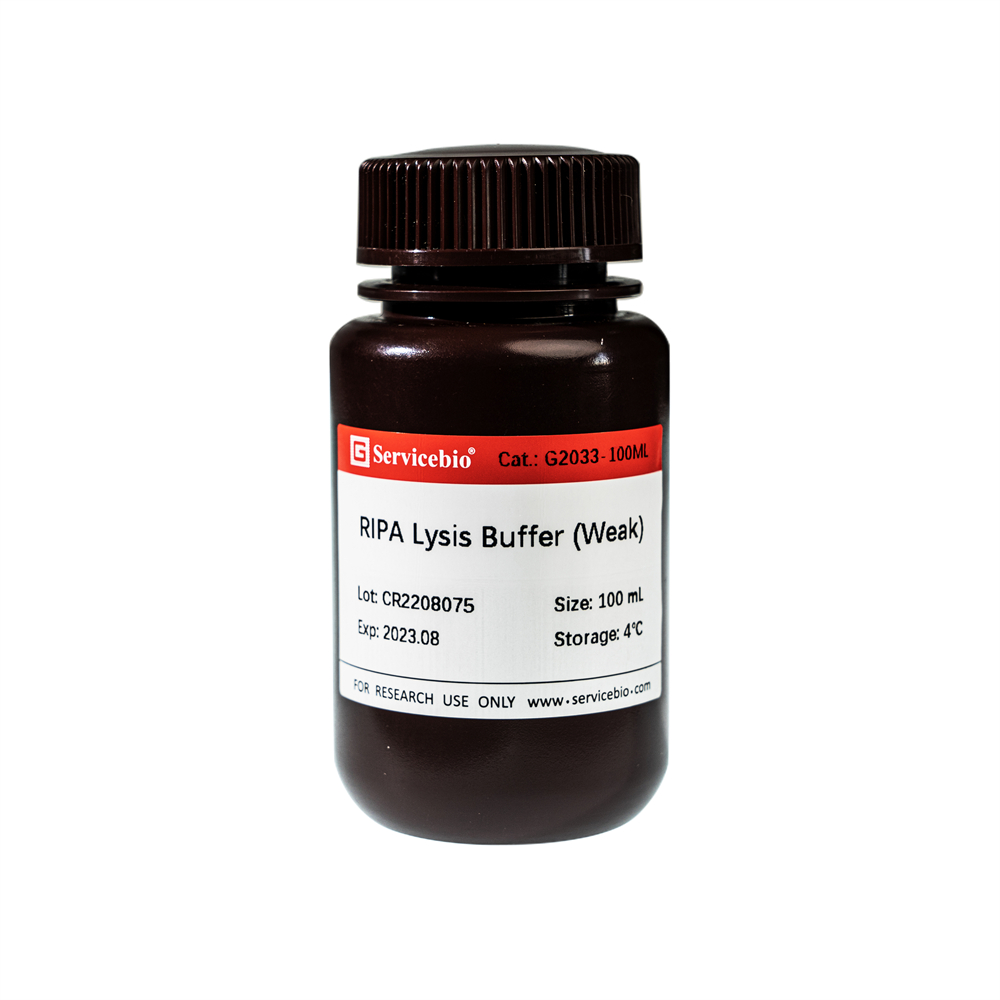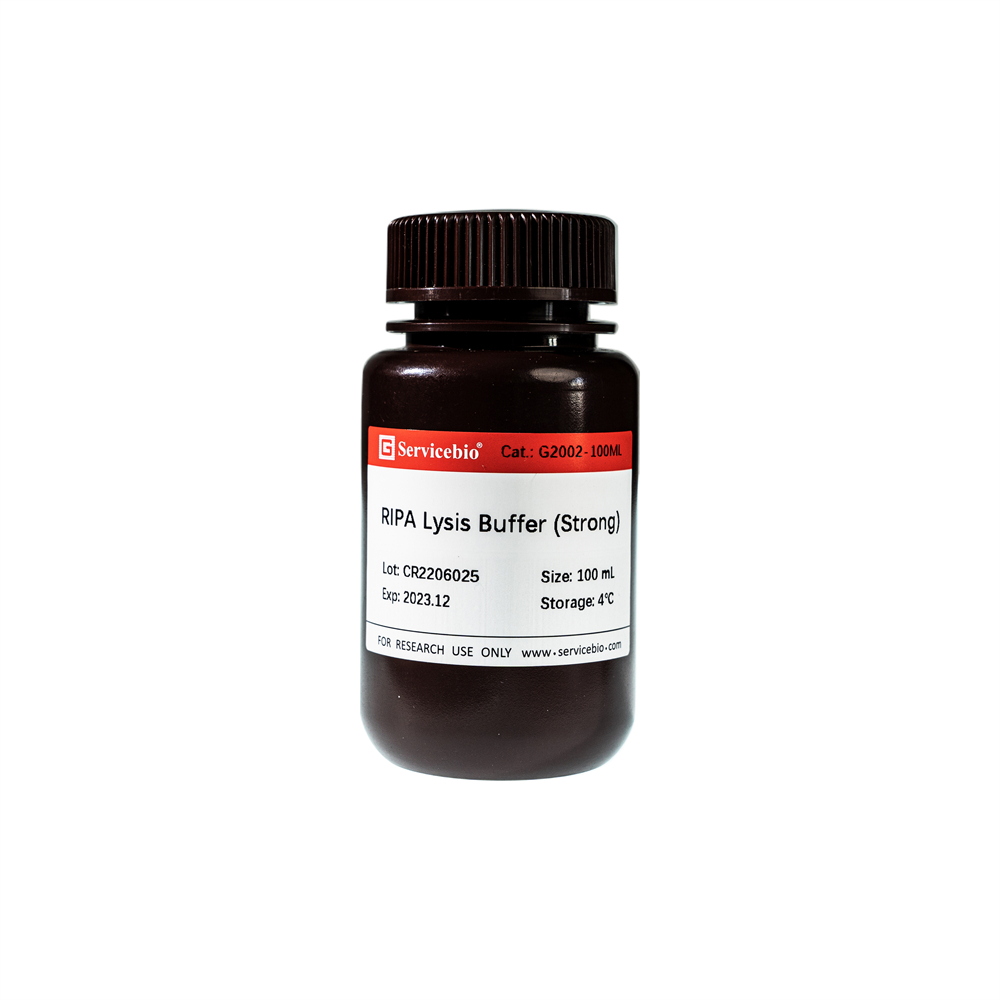Description
Product Information
| Product Name | Cat.No. | Spec. |
| IP Lysis Buffer | G2038-100ML | 100 mL |
Description
IP lysate is a lysate that lysates cells or tissues to prepare protein samples under non-denaturing conditions. Protein samples obtained from tissue or cell lysis with this lysate can be applied to PAGE, western blot and immunoprecipitation, IP), co-immunoprecipitation (co-IP), Chromatin Immunopre-cipitation (ChIP) and ELISA are required to maintain protein activity.
The main ingredients of this product are 25 mM Tris-HCl, 150 mM NaCl, 1 mM EDTA and 1% NP-40. Can be applied to animal or plant tissue and cell samples, can also be used for fungal or bacterial samples.
Storage and Handling Conditions
Transport with wet ice;Store at 4℃ away from light, valid for 12 months.
Component
| Component | G2038-10ML |
| IP Lysis Buffer | 100 mL |
| Product Manual | |
Assay Protocol
Protease inhibitors need to be prepared yourself. Protease inhibitors (G2006, G2007, G2008, etc.) should be added to IP lysate before clinical use to prevent protein degradation. The IP lysates mentioned in the following usage methods refer to the addition of protease inhibitors.
For tissue samples:
1. The tissue block was washed with pre-cooled PBS (G4202 recommended) to remove blood stains, and then cut into small pieces and placed in the homogenizer.
2. Add 10 times tissue volume IP lysate to homogenize at low temperature (high-speed tissue lapping instrument KZ-III-F and KZ-III-FP independently developed and produced by Servicebio are recommended). Note that the amount of IP lysate used can be added at a ratio of approximately 50 mg of tissue to 1 mL of lysate. If the tissue protein content is low, the amount of lysate can be reduced to increase the protein concentration in the crude extract solution.
3. Transfer the homogenate to a 1.5mL centrifuge tube and shake. Ice bath for 30 min, during which the pipette was blown repeatedly every 10 min to ensure complete lysis of tissue cells;
4. Centrifuge at 12000 g for 5 min and collect the supernatant, which is the total protein solution.
For adherent cell samples:
1. Wash the cells with PBS 2-3 times, and blot the residual liquid thoroughly at the last time.
2. Absorb IP lysate into the cell culture plate and flask according to the ratio of 250 μL lysate in each well of the 6-well plate, shake the culture plate and flask repeatedly, and make the lysate fully contact with the cells for 3-5 min.
3. Scrape off the cells with a cell scraper and collect them into a centrifuge tube.
4. Centrifuge at 12000 g for 5 min and collect the supernatant, which is the total protein solution.
For suspended cell samples:
1. Cells were collected by centrifugation.
2. Mix the cell fluid with IP lysate according to the ratio of 250 μL cell lysate in each well of the 6-well plate, and shake.
3. Ice bath for 30 min, during which the pipette is blown repeatedly for several times every 10 min to ensure complete cell lysis.
4. Centrifuge at 12000 g for 5 min and collect the supernatant, which is the total protein solution。
For bacterial or fungal samples:
1. 1 mL of the bacterial suspension was centrifuged to remove the supernatant and washed once with PBS to fully remove the liquid. The vortices make the thalli disperse as much as possible.
2. Add 100-200 μL IP lysate, gently vortex to mix the thallus and lysate thoroughly.
3. Ice bath for 10 min, during which the pipette was repeatedly blown several times every 2 min to ensure complete lysis of thalli.
4.12000 g centrifugation for 5 min, and the supernatant, which was the total protein solution, was collected.
Note:
1. Tissue or cells may become sticky when lysed. The pipette can be blown repeatedly or the vortexer can be oscillated until it becomes liquid. If it has been thicker, you can add an appropriate amount of lysate.
2. This reagent does not contain protease inhibitors, so it is necessary to prepare your own protease inhibitors and add them before use. The company’s G2006, G2007, G2008 and other related protease inhibitors are recommended.
3. The total protein solution obtained by cleavage of this product is compatible with the BCA protein quantitative detection kit (G2026) of our company.
4. For your safety and health, please wear a lab coat and disposable gloves when operating.
For Research Use Only!
|
Cat.No.
|
Product Name
|
Spec.
|
Operation
|
|---|
|
G2002-100ML
|
RIPA Lysis Buffer (Strong)
|
100 mL
|
|
|
G2002-30ML
|
RIPA Lysis Buffer (Strong)
|
30 mL
|
|
|
G2003-50T
|
SDS-PAGE Gel Preparation Kit
|
50 T
|
|
|
G2004-100ML
|
30% Acrylamide-Bisacrylamide (29:1)
|
100 mL
|
|
|
G2006-250UL
|
50×Cocktail Protease Inhibitor
|
250 μL
|
|
|
G2007-1ML
|
Phosphoprotease Inhibitor
|
1 mL×2
|
|
|
G2008-1ML
|
PMSF (100mM)
|
1 mL
|
|
|
G2018-1L
|
Tris-Glycine SDS-PAGE Running Buffer (Powder)
|
1 L
|
|
|
G2033-100ML
|
RIPA Lysis Buffer (Weak)
|
100 mL
|
|
|
G2033-30ML
|
RIPA Lysis Buffer (Weak)
|
30 mL
|
|
|
G2053-100ML
|
1.5 M Tris-HCl (pH 8.8)
|
100 mL
|
|
|
G2054-100ML
|
1 M Tris-HCl (pH 6.8)
|
100 mL
|
|
|
G2055-5ML
|
10% SDS Solution
|
5 mL
|
|
|
G6019-9
|
Antibody Incubation Box (9 Grids)
|
9 grids
|
|
|
G6020-9
|
Antibody Incubation Box (9 Grids Light-Proof)
|
9 Grids Light-Proof
|
|
|
G6025-2
|
Antibody Incubation Box (2 Grids)
|
2 grids
|
|
|
G6026-4
|
Antibody Incubation Box (4 Grids)
|
4 grids
|



